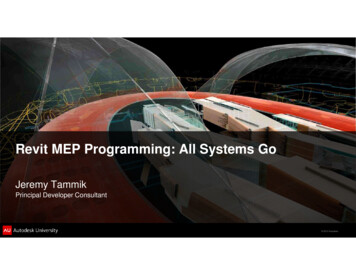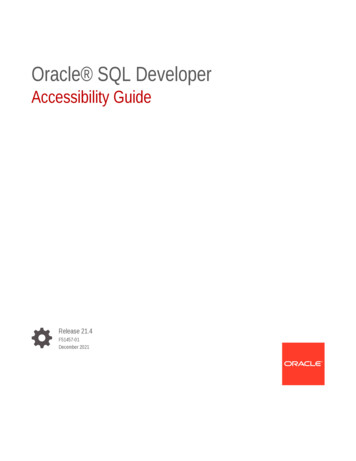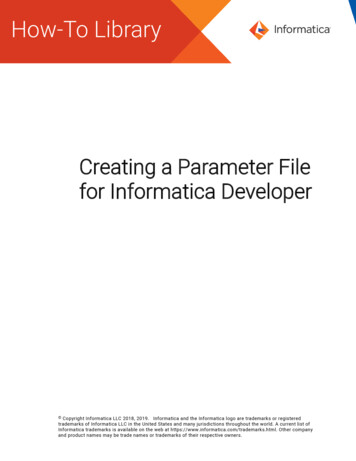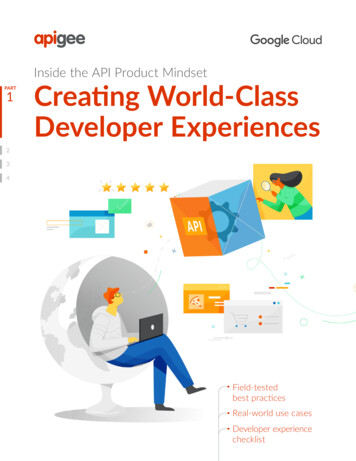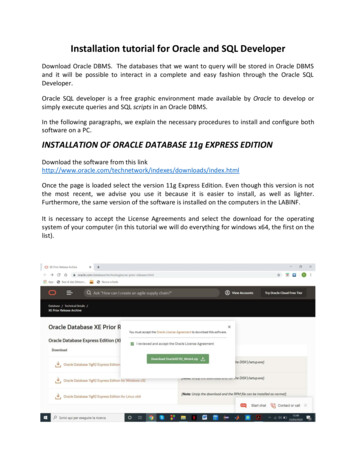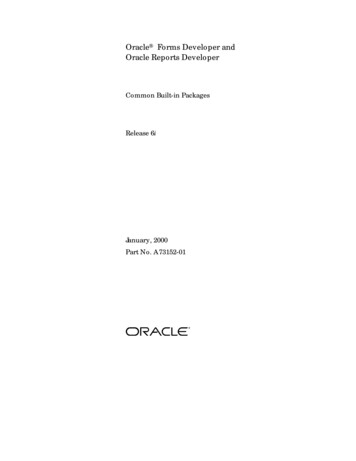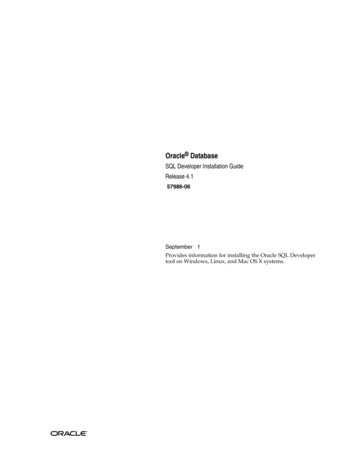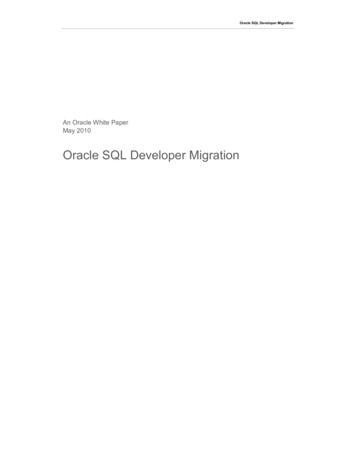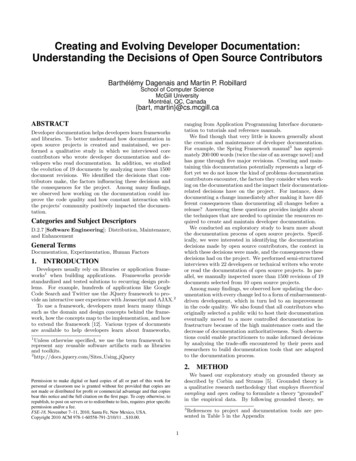
Transcription
Creating and Evolving Developer Documentation:Understanding the Decisions of Open Source ContributorsBarthélémy Dagenais and Martin P. RobillardSchool of Computer ScienceMcGill UniversityMontréal, QC, Canada{bart, martin}@cs.mcgill.caABSTRACTranging from Application Programming Interface documentation to tutorials and reference manuals.We find though that very little is known generally aboutthe creation and maintenance of developer documentation.For example, the Spring Framework manual3 has approximately 200 000 words (twice the size of an average novel) andhas gone through five major revisions. Creating and maintaining this documentation potentially represents a large effort yet we do not know the kind of problems documentationcontributors encounter, the factors they consider when working on the documentation and the impact their documentationrelated decisions have on the project. For instance, doesdocumenting a change immediately after making it have different consequences than documenting all changes before arelease? Answering these questions provides insights aboutthe techniques that are needed to optimize the resources required to create and maintain developer documentation.We conducted an exploratory study to learn more aboutthe documentation process of open source projects. Specifically, we were interested in identifying the documentationdecisions made by open source contributors, the context inwhich these decisions were made, and the consequences thesedecisions had on the project. We performed semi-structuredinterviews with 22 developers or technical writers who wroteor read the documentation of open source projects. In parallel, we manually inspected more than 1500 revisions of 19documents selected from 10 open source projects.Among many findings, we observed how updating the documentation with every change led to a form of embarrassmentdriven development, which in turn led to an improvementin the code quality. We also found that all contributors whooriginally selected a public wiki to host their documentationeventually moved to a more controlled documentation infrastructure because of the high maintenance costs and thedecrease of documentation authoritativeness. Such observations could enable practitioners to make informed decisionsby analyzing the trade-offs encountered by their peers andresearchers to build documentation tools that are adaptedto the documentation process.Developer documentation helps developers learn frameworksand libraries. To better understand how documentation inopen source projects is created and maintained, we performed a qualitative study in which we interviewed corecontributors who wrote developer documentation and developers who read documentation. In addition, we studiedthe evolution of 19 documents by analyzing more than 1500document revisions. We identified the decisions that contributors make, the factors influencing these decisions andthe consequences for the project. Among many findings,we observed how working on the documentation could improve the code quality and how constant interaction withthe projects’ community positively impacted the documentation.Categories and Subject DescriptorsD.2.7 [Software Engineering]: Distribution, Maintenance,and EnhancementGeneral TermsDocumentation, Experimentation, Human Factors1.INTRODUCTIONDevelopers usually rely on libraries or application frameworks1 when building applications. Frameworks providestandardized and tested solutions to recurring design problems. For example, hundreds of applications like GoogleCode Search and Twitter use the JQuery framework to provide an interactive user experience with Javascript and AJAX.2To use a framework, developers must learn many thingssuch as the domain and design concepts behind the framework, how the concepts map to the implementation, and howto extend the framework [12]. Various types of documentsare available to help developers learn about frameworks,1Unless otherwise specified, we use the term framework torepresent any reusable software artifacts such as librariesand toolkits.2http://docs.jquery.com/Sites Using jQuery2.METHODWe based our exploratory study on grounded theory asdescribed by Corbin and Strauss [5]. Grounded theory isa qualitative research methodology that employs theoreticalsampling and open coding to formulate a theory “grounded”in the empirical data. By following grounded theory, wePermission to make digital or hard copies of all or part of this work forpersonal or classroom use is granted without fee provided that copies arenot made or distributed for profit or commercial advantage and that copiesbear this notice and the full citation on the first page. To copy otherwise, torepublish, to post on servers or to redistribute to lists, requires prior specificpermission and/or a fee.FSE-18, November 7–11, 2010, Santa Fe, New Mexico, USA.Copyright 2010 ACM 978-1-60558-791-2/10/11 . 10.00.3References to project and documentation tools are presented in Table 5 in the Appendix1
started from general research questions and refined the questions, and the data collection instruments, as the study progressed. As opposed to random sampling, grounded theoryinvolved refining our sampling criteria throughout the courseof the study to ensure that the selected participants wereable to answer the new questions that have been formulated.For example, after having interviewed two contributors ofPerl projects, we filtered out further Perl projects; after having interviewed four contributors from library projects, wesent more invitations to contributors of framework projects.We analyzed the data, collected through interviews anddocument revisions, using open coding: we assigned codesto sentences, paragraphs, or revisions and we refined themas the study progressed. We then reviewed the codes several times and linked them to emerging categories, a process called axial coding. Finally, the goal of a study usinggrounded theory is to produce a coherent set of hypotheseslaid in the context of a process, that originates from empirical data. Although all reported observations are linked tospecific cataloged evidences, we elide some of these links forthe sake of brevity.4Our method follows that of previous software engineeringstudies based on grounded theory [1, 8, 9]. These referencesprovide an additional discussion on the use of grounded theory in software og.Lang.U1U2U3U4U5U6U7U8U9U10 Web ApplicationsSystem Prog., DatabaseSystem Prog.System SimulatorsWeb ApplicationsFinancial ApplicationsWeb ApplicationsDatabaseWeb ApplicationsWeb ApplicationsJava, PHPPerlCC,C ,JavaPython, Java, CJavaPHPC PHPPHP1010201055525253Table 1: Documentation users1. The project offered some reuse facilities for programmers (e.g., frameworks, libraries, toolkits, extensibleapplications),2. The project was more than one year old.3. There was at least one active contributor in the lastyear (e.g., a contributor answered a question on themailing list in 2009).4. The project had more than 10k lines of source code.5. The project had more than 1000 users (measured bythe number of downloads, issue reporters, or mailinglist subscribers).Data CollectionWe selected projects from a wide variety of application domains and programming languages to ensure that our findings were not specific to one domain in particular.After having selected a project, we looked at its web siteand at the source repository to identify the main documentation contributors. When in doubt, we contacted one ofthe founders or core maintainers. We sent 49 invitations tocontributors, 12 of which accepted to do an interview.Each contributor who accepted our invitation participatedin a 45-minute semi-structured phone interview in which weasked open-ended questions such as “how did the documentation evolve in your project?” and “what is your workflowwhen you work on the documentation?”.A few contributors talked about various projects theyworked on or used, but most contributors focused on oneproject. The programming language of the projects variedgreatly: Perl (2 contributors), Java (2), Javascript (1), C(2),C (1), PHP (2), Python (2). The age of the projectsranged from 1.5 years to more than 15 years with an average of 8.7 years. The application domains were also varied:programming language library (4), database or databindinglibrary (3), web application framework (3), blogging platform (1), and web server (1). Finally, all of our participantshad more than five years of programming or technical writing experience (up to 25 years).The Users. To recruit developers who used open sourceprojects and read documentation, we relied on the list ofusers of stackoverflow.com, a popular collaborative web sitewhere programmers can ask and answer questions. We wantedto interview users who had various amounts of expertise interms of programming languages and years of programmingexperience. Stackoverflow user profiles indicate how manyquestions each user has asked and answered and the tagsassociated with these questions (e.g., a question might berelated to java and eclipse). We filtered out all users whodid not have contact information published on their profileand who were primarily answering questions related to theWe learned about the documentation process of open sourceprojects by gathering data from three sources. We interviewed developers who contributed to open source projectsand their documentation (the contributors): these developers were often the founder or the core maintainer of theproject.5 Most of the observations reported in this papercome from these interviews. We also interviewed developers who frequently used open source projects and who readtheir documentation (the users). We wanted to determinehow developers used documentation and what kind of documentation was the most useful to them. Finally, we analyzed the evolution of 19 documents from 10 open sourceprojects (the historical analysis). Because some projectsstarted more than 15 years ago, it was often difficult for theparticipants to remember the various details of the documentation process. Our systematic analysis of the revisionsprovided us with a more comprehensive and detailed viewof that documentation’s evolution.The projects of the contributors, the users, and the historical analysis were selected in parallel so they are not necessarily the same. We used this strategy to preserve theanonymity of the contributors and to allow us to provideconcrete examples by naming real open source projects whendiscussing observations from the users’ interviews and thehistorical analysis. Additionally, this sampling strategy enabled us to perform data triangulation by evaluating ourobservations on different projects.The Contributors. To recruit contributors, we began bymaking a list of open source projects that were still beingused by a community of users and that were large enough torequire documentation to be used. We only selected projectsthat fulfilled these five criteria:4Specific evidence will be provided upon request.Unless otherwise specified, we assume that the contributorshave commit access to their project’s repository.52
S#C%CCDjangoPythonWeb Fmk.Tutorial Part 1Tutorial Part 3Model dPressPHPBlogging PlatformWriting a Plug-inPlug-in API252320134.004.751261275656wikiwikiKDE PlasmaC GUI Fmk.Getting StartedPlasma e 3JavaDatabinding Fmk.QuickStartCollections ation Fmk.Beans 6%GTK CGUI Fmk.GTK 2.0 Tutorial567659.00541028%FirefoxXMLWeb BrowserHow to build an extension31634.25316143wikiDBIPerlDatabase Lib.Module Documentation342215.00145319%ShoesRubyGUI Fmk.Manual188871.003456%EclipseJavaApplication Fmk.Creating the plug-in projectApplication DialogsDocuments and PartitionsResources and the file 4%8%8%Table 2: Evolution of documents.NET platform because we judged that they were less likelyto have a rich experience with open source projects.6We sent 38 invitations and recruited 10 participants. Wesent each participant an email asking for a list of opensource projects that had good or bad documentation. Wepurposely did not define good or bad documentation because we wanted the participants to elaborate on their definition during the interview. Each developer participated ina 30-minute semi-structured phone interview that focusedon their experience with the documentation of the projectsthey selected, and then, on their experience with documentation in general.Table 1 shows the profile of the developers we interviewed:the number of years of programming experience, the mainfield they are professionally working in, and the programming languages they mentioned during the interview. Mostparticipants used many open source projects as part of theirwork or as part of hobby projects so their documentationneeds are not exclusive to their field of work.The Historical Analysis. We systematically analyzedthe evolution of documents of open source projects thatmaintained their documentation in a source repository (e.g.,CVS) or in a wiki. We also used the same criteria as for thecontributors to select projects for our historical analysis.For each project, we selected from one to four documents.The first document was a tutorial or a similar documentthat told users how to get started with the project. Thesecond document was a reference (e.g., list of properties).We assumed that these two types of documents were distinctenough that they might exhibit different evolution patterns.We had to analyze a different number of documents perproject because there is no documentation standard acrossprojects and it was impossible to compare documents of thesame size or of the same nature. For example, documentsranged from a complete manual in one file (e.g., the GTKTutorial) to document sections separated in small files andpresented on many pages (e.g., Eclipse help files).We analyzed the history of the documents by looking attheir change comments and by comparing each version of thedocuments. This was necessary because often the changecomment was not clear enough. For example, a commitcomment mentioned fixing a “typo”, but in fact, the actualchange shows a code example being modified. Through several passes of open coding, we assigned a code to each revision to summarize the rationale behind the change. Table 2shows descriptive statistics of the documents we inspectedsuch as the time between the first and last revision thatwe could find (in years), the number of change sets (#CS),the number of different committers who modified the files(#C), and the percentage of revisions that originated fromcommunity contributions (%CC). We report the details ofthe revision classification in Appendix A.We considered that all revisions that mentioned a bugnumber, a contributed patch, or a post from a forum ora mailing list originated from the community. It was notalways possible to determine the source of the change whenthe documents were hosted on a wiki, so we indicated “wiki”in the table.73.CONCEPTUAL FRAMEWORKFollowing the analysis of the interviews and the documentrevisions, we identified three production modes in which documentation of open source projects is created. Although weexpected documentation to be produced in different modes,the study helped us concretize what these modes were andwhat they corresponded to in practice. These productionmodes guided our analysis of the main decisions made bycontributors (Section 4). Figure 1 depicts how the documentation effort was distributed in the lifecycle of the opensource projects we studied. First, contributors create theinitial documentation, which requires an upfront effort thatis higher than the regular maintenance effort. Then, as the6The documentation experience of .NET developers is ofinterest, but not for this particular study on open sourceprojects. We are aware that with the CodePlex project(www.codeplex.com), open source projects in .NET are becoming more mainstream.7This is only a rough estimate because core contributorssometimes create bug reports themselves and other times,they forget to include the source of the change request.3
are used by contributors, sometimes in combination witheach other: wikis (see Section 4.1), documentation suites(e.g., POD, Sphinx, or Javadoc), and general documentssuch as HTML. In our historical analysis, we observed thatthe editing errors (e.g., forgetting a closing tag) caused bythe syntax of any documentation infrastructure were responsible for an important amount of changes and that bettertool support could probably mitigate this problem: 55.4%in Eclipse (HTML), 11.4% in Django (Sphinx), 11.1% inGTK (SGML), and 6.7% in WordPress (wiki).A second decision point that developers encounter earlyon concerns the type of documentation to create. Contributors typically create one type of documentation initially andthe documentation covers only a subset of the code. Then,as the project evolves, contributors create more documentsof various kinds. After analyzing the interviews of both contributors and users, we identified three types of documentation based on their focus: a task is the unit of getting starteddocumentation (Section 4.2), a programming language element (e.g., a function) is the unit of reference documentation(Section 4.3), and a concept is the unit of conceptual documentation. These documentation types are consistent withsome previous classification attempts [2, 3].Incremental Changes. Small and continuous incremental changes are the main force driving the evolution of opensource project documentation. We noticed in our historical analysis that all changes except a few structural changesand the first revisions concerned a few words or a few linesof code and that these changes occurred regularly throughout the project history (see Table 4 in the Appendix). Inthis production mode, open source contributors encountertwo major decision points: how to adapt the documentationto the project’s evolution and how to manage the projectcommunity’s contributions.We found in our historical analysis that software evolutionmotivated at least 38% of the revisions to the documents weanalyzed (adaptation and addition changes). We encountered five strategies (i.e., decisions) that contributors usedto adapt the documentation to the project’s evolution: contributors (1) updated the documentation with each change(Section 4.4), (2) updated the documentation before eachrelease, (3) relied on a documentation team to documentthe changes (Section 4.5), (4) wrote the documentation before the change and used it as a specification, or (5) did notdocument their changes.The second decision point contributors encounter is todetermine how to manage the documentation contributionsfrom the community. These contributions come in variousforms: (1) documented code patches (Section 4.4), (2) documentation patches, (3) documentation hosted outside theofficial project’s web site, (4) comments and questions askedon official support channels (Section 4.6), and (5) external support channels such as stackoverflow.com. Managingthe documentation contributions represents a large fractionof the documentation effort: in our historical analysis, wefound that 28% of the document revisions, excluding documents on wikis, originated from the community.Bursts. During a project’s lifetime, the documentation occasionally goes through major concerted changes that wecall bursts. These changes improve the quality of the documentation, but they require such effort that they are notdone regularly.Figure 1: Documentation production modesFactors nces DecisionEffortImpacts onProject.Figure 2: Decisions made in a documentation production modesoftware evolves, contributors incrementally change the documentation in small chunks of effort (e.g., spending 20 minutes to clarify a paragraph). Sometimes, major documentation tasks such as the writing of a book on the projectrequires a burst of documentation effort.In addition to the three production modes, we note thatdocumentation writers make important decisions at specificdecisions points. As illustrated in Figure 2, decisions areinfluenced by contextual factors and they have consequencesin terms of required effort and impacts for the project. Thispaper focuses on the relationships between the decisions,their factors, and their consequences.For example, for the decision point “When to adapt thedocumentation to the project’s evolution”, there are manypossible decisions (e.g., updating the documentation shortlyafter making a change, before an official release, before making a change, etc.). The decisions related to a decisionpoint are not mutually exclusive, but each decision has somespecific effort and impact associated with it. The consequences of a decision can also become a factor over time.For example, four contributors sought to document theirchanges as quickly as possible after realizing that they often improved their code while documenting. We analyzedthe consequences of the documentation decisions from manyperspectives (contributors, users, and evolution) to evaluatethe trade-offs involved with each decision.4.DECISIONSWe provide an overview of the documentation productionmodes and the decisions points. Then, we discuss in detailthe six decisions that had the largest impact on the documentation creation and maintenance of the projects we studied, as determined by our analysis. Underlined sentencesrepresent major observations for each decision. Table 3 provides a summary of the consequences of these six decisionson five aspects of open source projects.Initial Effort. When a project starts, contributors encounter two main decision points. First, contributors mustselect tools to create, maintain, and publish the documentation. There are three main types of infrastructure that4
Publishers sometimes approach contributors of open sourceprojects to write books about their projects: six contributorsin our study mentioned that they (or their close collaborators) wrote books. One consequence of writing books is thatcontributors think more about their design decisions: “itforced me to be more precise, to think carefully about whatI wrote”C3 .8 This particular contributor made many smallchanges to clarify the content of the official documentationwhile he was writing the book. Because books about opensource projects are not always updated, their main advantage lies in the improvement of the quality of the officialdocumentation and the time that the contributors take toreflect on their design decisions.Contributors also change the documentation infrastructure when it becomes too costly to maintain. Maintenanceissues either come from custom tool chains, “it is so complexthat our release manager can’t build the documentation onhis machine”C4 , or from a barrier of entry that is not highenough (e.g., wiki).The last type of burst efforts are the major reviews initiated by the documentation contributors themselves. Duringthese reviews, contributors can end up rewriting the wholedocumentation (C5) or simply restructuring its table of contents (C8). We observed that major reviews lasted from sixweeks (C7) to three years (C9).4.1For example, we observed cases such as a revision in a Firefox tutorial where one line of a code example was erroneouslymodified (possibly in good faith). The change was only discovered and reverted one day later (June 13th 2006).Finally, because the barrier to entry is low, i.e., there isnot much effort required to modify the documentation, thedocumentation can become less concise and focused overtime: “there’s a user-driven desire to make sure that everysingle possible situation is addressed by the documentation.[these situations] were unhelpful at best and just clutter atworst”C5 . According to C7, managing public wikis of largeprojects is a full-time job.Alternatives. As users and contributors mentioned, thecommunity is less inclined to contribute documentation thanit is to contribute code, so the barrier to contribute documentation must be lower than the barrier to contribute code.Still, there exist mechanisms that encourage user contributions and that do not sacrifice authoritativeness, such as allowing user comments at the bottom of documents. Anotherstrategy is to explicitly ask for feedback within the documents. For example, we observed in our historical analysisthat Django provides a series of links to ask a question or toreport an issue with the documentation on every page. Hibernate provides a similar link on the first page of the manual only. We could not find such a link in the Eclipse documentation. This strategy could explain in part the numberof revisions that were motivated by the community: Django:48%, Hibernate: 10%, and Eclipse: 10%.Wiki as Documentation InfrastructureWe begin our description of major decisions with the selection of a public wiki to host the documentation infrastructure. Wikis enable contributors to easily create a website that allows anybody to contribute to the documentation, offers a simple editing syntax, and automatically keepstrack of the changes to the documentation.Context. Contributors select wikis to host their documentation when the programming language of the project is notassociated with any infrastructure (such as CPAN with Perl)or when the project contributors want to rely on crowdsourcing to create documentation, i.e., they hope that users willcreate and manage the documentation.Public wikis also offer one of the lowest barriers to entry:the contribution is one click away. According to contributors like C7, it is a powerful strategy to build a communityaround the project: C7 started to contribute on his projectby fixing misspelled words.Consequences. Although wikis initially appear to be aninteresting choice for contributors, all the projects we surveyed that started on a wiki (4 out of 12) moved to an infrastructure where contributions to the documentation aremore controlled. As one contributor mentioned: “the qualityof the contributions. it’s been [hesitating] ok. sometimes[it] isn’t factual so we had to change that. but the problemhas been SPAM”C1 . Indeed, we observed in our historicalanalysis that projects on wikis are often plagued by SPAM(24.1% of the revisions in Firefox) or by the addition of URLsthat do not add any valuable content to the documentation(e.g., a link to a tutorial in a list already containing 20 links).Another problem with wikis is that they lack authoritativeness, an important issue according to our users: “I don’twant to look at a wiki that might be outdated or incorrect”U 34.2Getting Started as Initial DocumentationGetting started documentation describes how to use a particular feature or a set of related features. It can range froma small code snippet (e.g., the synopsis section at the beginning of a Perl module) to a full scale tutorial (e.g., thefour-part tutorial of Django).Context. Contributors create getting started documentation as the first type of documentation so that users caninstall and try the project as quickly as possible. Contributor C8 mentioned that for open source projects, gettingstarted documentation is the best kind of documentation tostart with because once a user knows how to use the basicfeatures, it is possible to look at the source code to learn thedetails of the API.For seven contributors, “getting started” documentationhas not only a training purpose, but it also serves as amarketing tool, it should “hook users”C1 , specifically whenthere are many projects competing in the same area. In contrast, the contributors of the five oldest projects reportedthat there was no marketing purpose behind the gettingstarted documentation: these projects were the first to bereleased in their respective field and the contributors wrotethe documentation for learning purpose only.Contributors of libraries that offer atomic functions thatdo not interact with each other felt that getting starteddocumentation was difficult to create because no reasonablecode snippet could give an idea of the range of features offered by the libraries. These contributors still tried to createa document that listed the main features or the main differences with similar libraries.Consequences. The importance of getting started documentation was confirmed by users who mentioned examplesof projects they selected because their documentation enabled them to get started faster and to get a better idea8Identifiers are associated with quotes for traceability and todistinguish between participants. Identifiers of contributorsand users begin with a “C” and “U” respectively.5
of the provided features. For example, U5 selected Djangoover Rails because the former had the best getting starteddocumentation, even though the latter looked more “powerful”U 5 . C2 confirmed that users evaluate Perl projects bylooking at their synopsis.Writing getting started documentation is challenging though:“technical writing. I didn’t have much exposure. I got usedto it to some degree, but it is a challenge. it can take a lotof time”C6 . Finding a good example on which to base thegetting started documentation, an example that is realisticbut not too contrived, is difficult (C11).4.3Reference Documentation as InitialDocumentationContributors may decide to initially focus on referencedocumentation by systematically documenting the API, theproperties, the options and the syntax used by a project.Context. When a library offers mostly atomic functions,reference documentation is the most appropriate documentation type to begin with because, as contributor C11 mentioned, it can be difficult to create getting
the creation and maintenance of developer documentation. For example, the Spring Framework manual3 has approxi-mately 200 000 words (twice the size of an average novel) and has gone through ve major revisions. Creating and main-taining this documentation potentially represents a large ef-fort yet we do not know the kind of problems documentation
